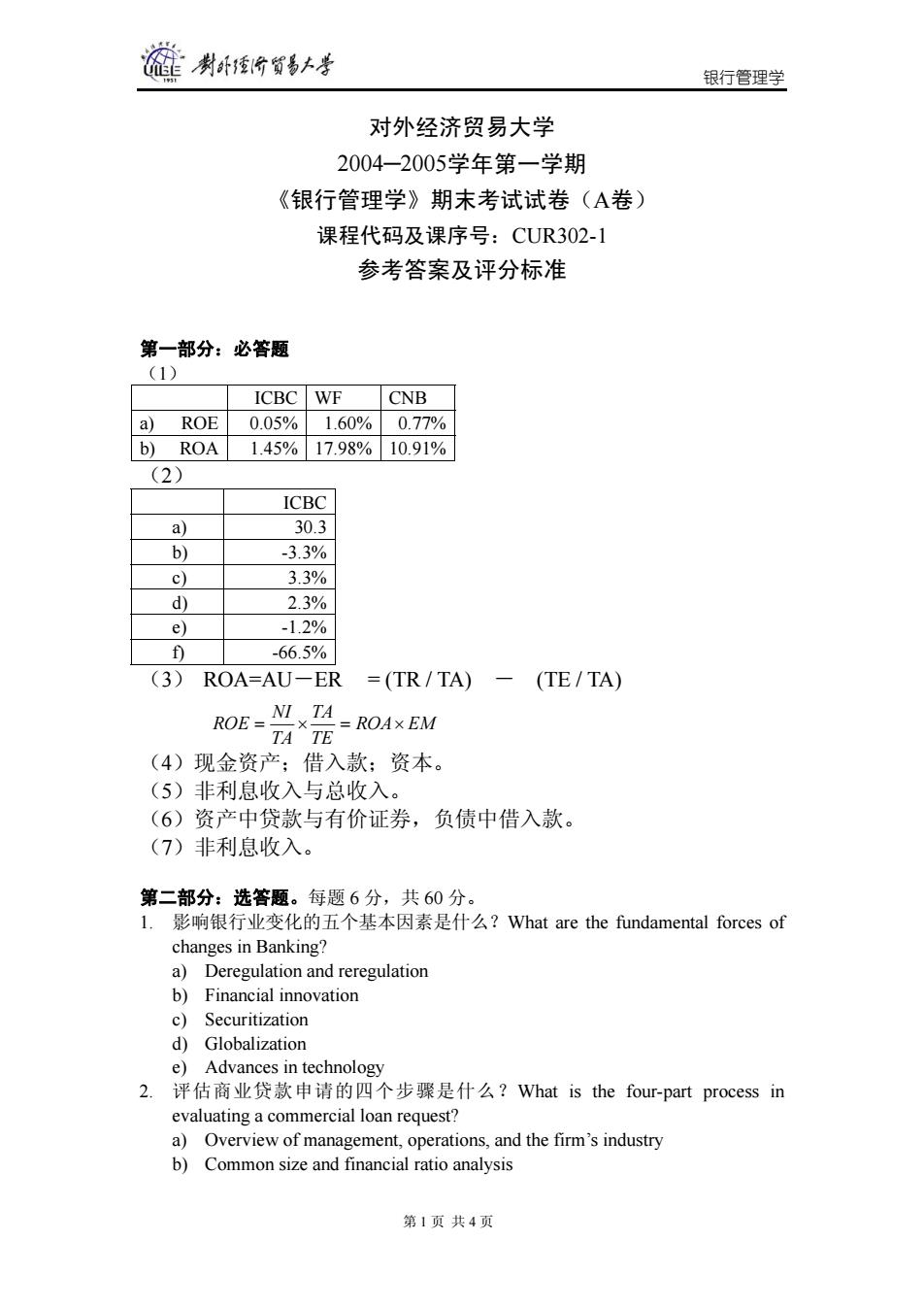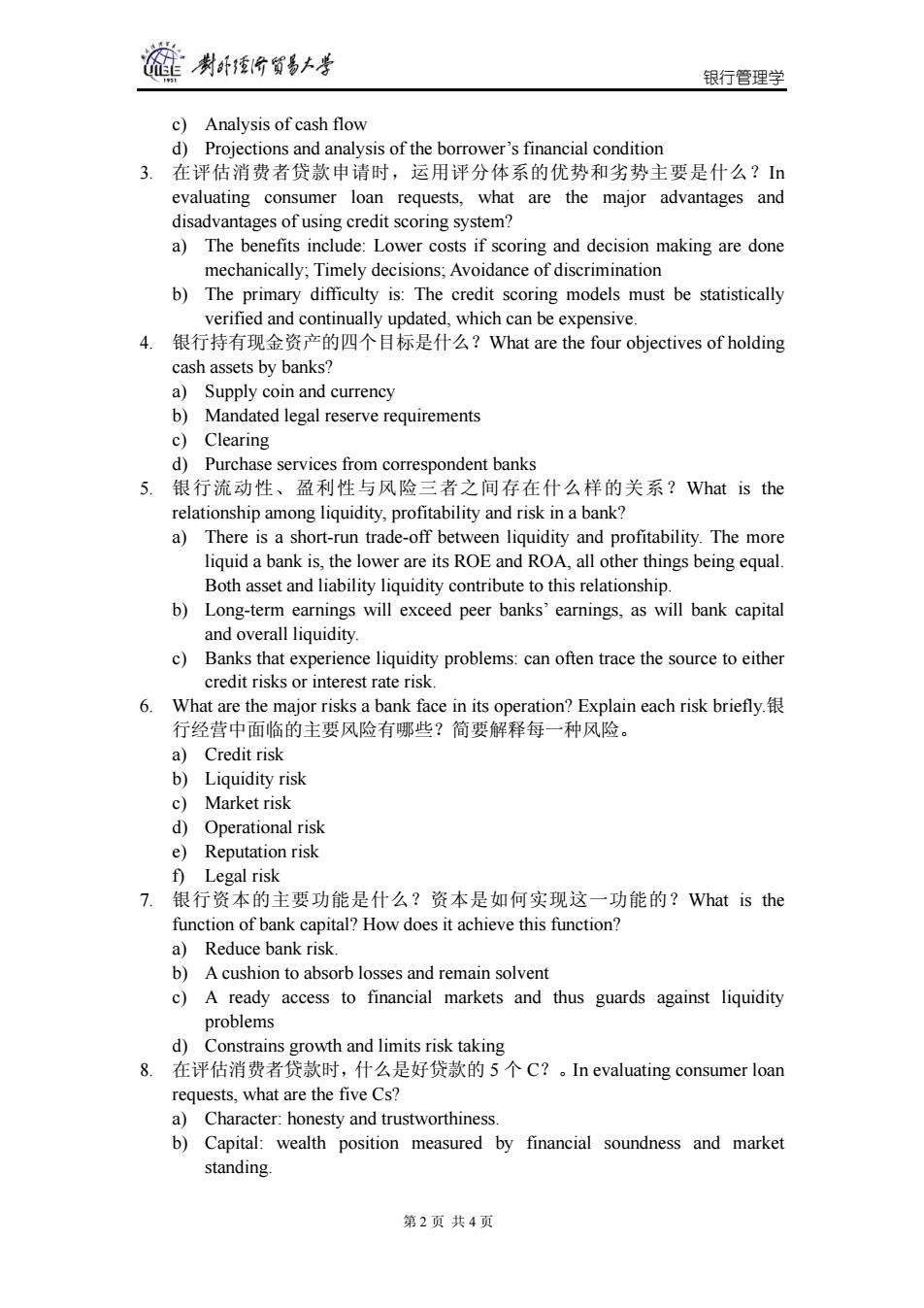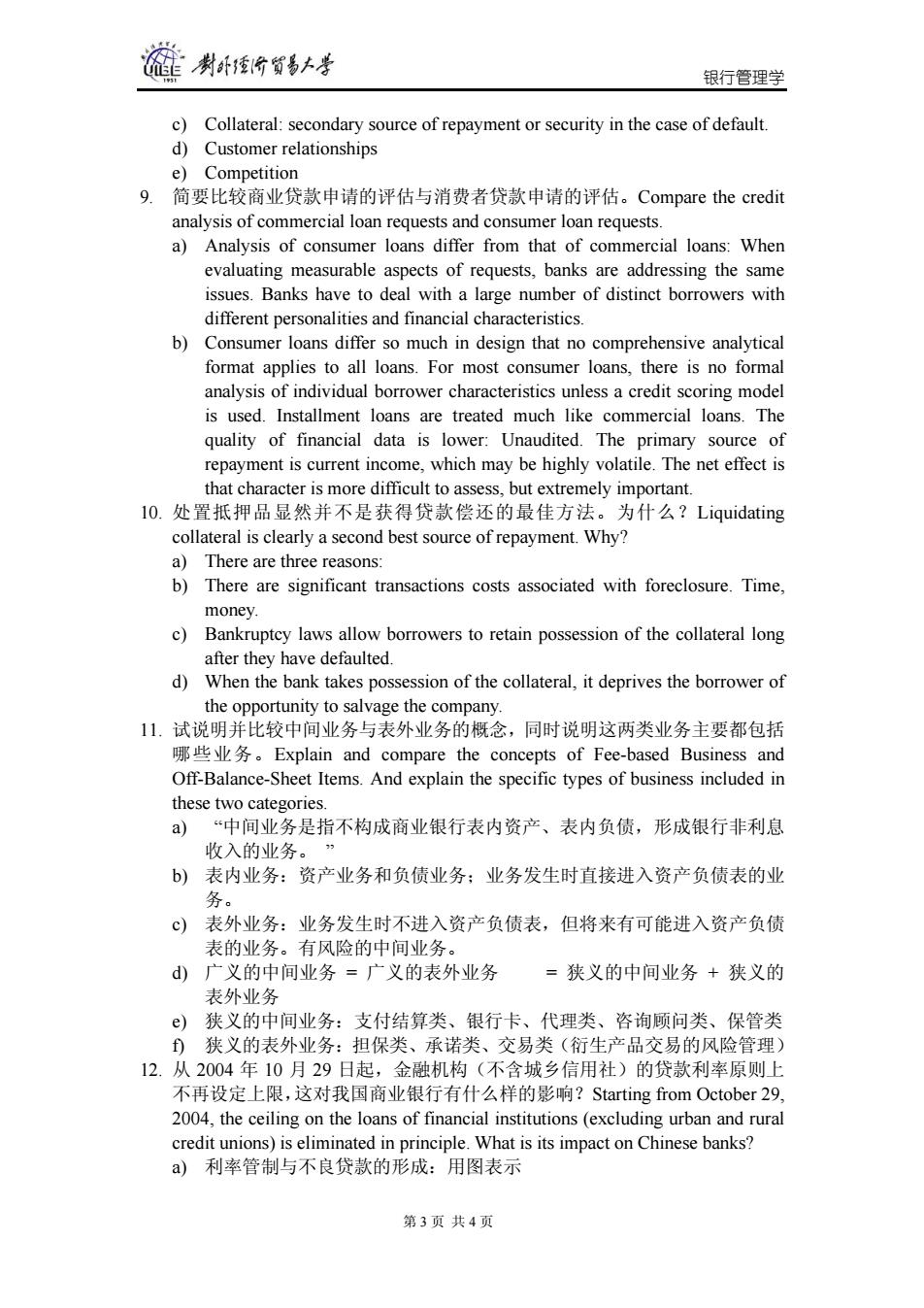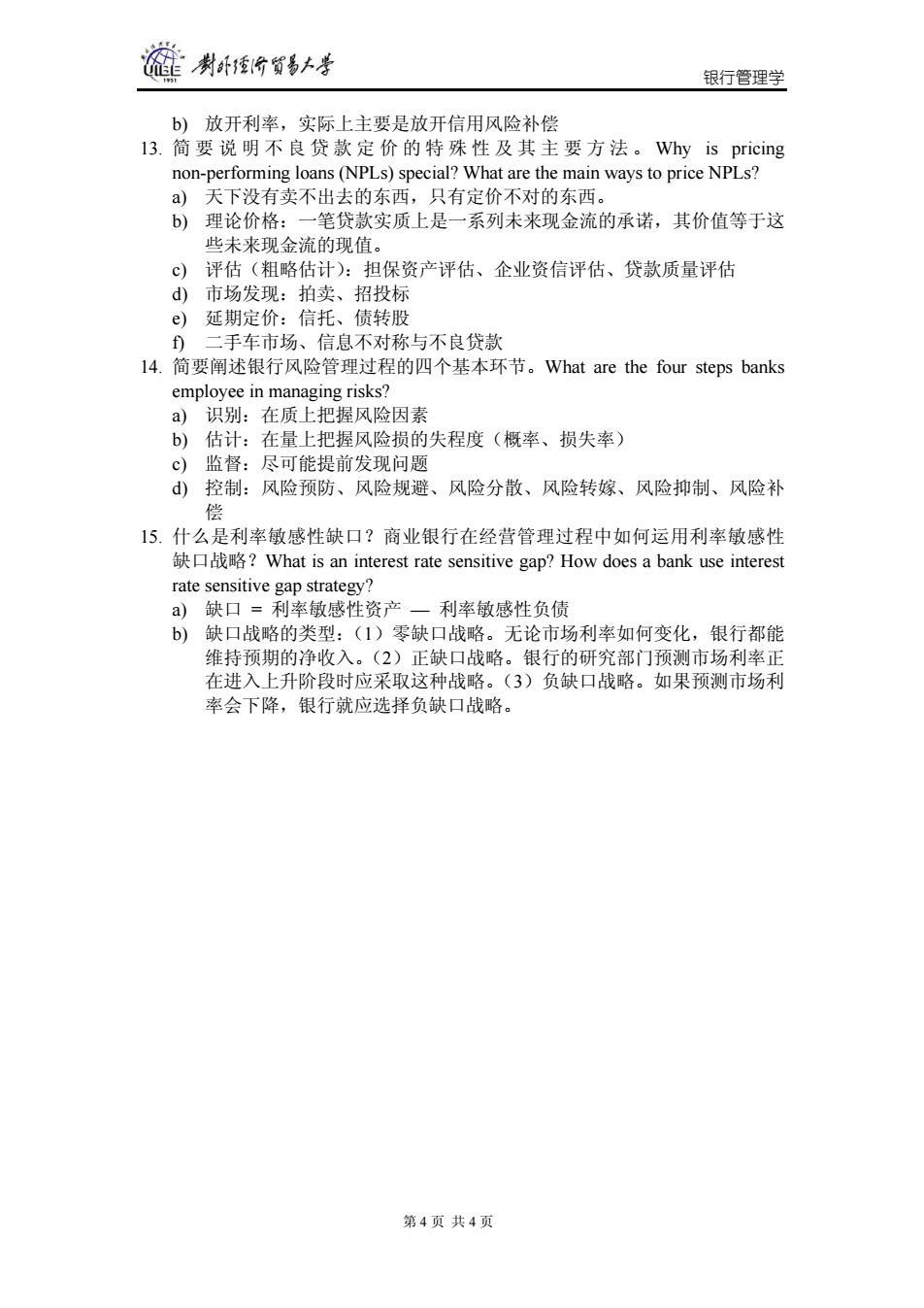
莲 制纤行贸多本考 银行管理学 对外经济贸易大学 2004-2005学年第一学期 《银行管理学》期末考试试卷(A卷) 课程代码及课序号:CUR302-1 参考答案及评分标准 第一部分:必答题 (1) ICBC WF CNB a) ROE 0.05% 1.60% 0.77% b) ROA 1.45% 17.98% 10.91% (2) ICBC a) 30.3 b) -3.3% c) 3.3% d 2.3% e) -1.2% f) -66.5% (3)ROA=AU-ER =(TR/TA)- (TE/TA) ROE= NI TA =ROA×EM TA TE (4)现金资产;借入款:资本。 (5)非利息收入与总收入。 (6)资产中贷款与有价证券,负债中借入款。 (7)非利息收入。 第二部分:选答题。每题6分,共60分。 L.影响银行y业变化的五个基本因素是什么?What are the fundamental forces of changes in Banking? a)Deregulation and reregulation b)Financial innovation c) Securitization d)Globalization e)Advances in technology 2.评估商业贷款申请的四个步骤是什么?What is the four-part process in evaluating a commercial loan request? a)Overview of management,operations,and the firm's industry b)Common size and financial ratio analysis 第1页共4页
银行管理学 对外经济贸易大学 2004─2005学年第一学期 《银行管理学》期末考试试卷(A卷) 课程代码及课序号:CUR302-1 参考答案及评分标准 第一部分:必答题 (1) ICBC WF CNB a) ROE 0.05% 1.60% 0.77% b) ROA 1.45% 17.98% 10.91% (2) ICBC a) 30.3 b) -3.3% c) 3.3% d) 2.3% e) -1.2% f) -66.5% (3) ROA=AU-ER = (TR / TA) - (TE / TA) ROA EM TE TA TA NI ROE = × = × (4)现金资产;借入款;资本。 (5)非利息收入与总收入。 (6)资产中贷款与有价证券,负债中借入款。 (7)非利息收入。 第二部分:选答题。每题 6 分,共 60 分。 1. 影响银行业变化的五个基本因素是什么?What are the fundamental forces of changes in Banking? a) Deregulation and reregulation b) Financial innovation c) Securitization d) Globalization e) Advances in technology 2. 评估商业贷款申请的四个步骤是什么?What is the four-part process in evaluating a commercial loan request? a) Overview of management, operations, and the firm’s industry b) Common size and financial ratio analysis 第 1 页 共 4 页

”制卧份贸易+考 银行管理学 c)Analysis of cash flow d)Projections and analysis of the borrower's financial condition 3.在评估消费者贷款申请时,运用评分体系的优势和劣势主要是什么?I evaluating consumer loan requests,what are the major advantages and disadvantages of using credit scoring system? a)The benefits include:Lower costs if scoring and decision making are done mechanically;Timely decisions;Avoidance of discrimination b)The primary difficulty is:The credit scoring models must be statistically verified and continually updated,which can be expensive. 4.银行持有现金资产的四个目标是什么?What are the four objectives of holding cash assets by banks? a)Supply coin and currency b)Mandated legal reserve requirements c)Clearing d)Purchase services from correspondent banks 5.银行流动性、盈利性与风险三者之间存在什么样的关系?What is the relationship among liquidity,profitability and risk in a bank? a)There is a short-run trade-off between liquidity and profitability.The more liquid a bank is,the lower are its ROE and ROA,all other things being equal. Both asset and liability liquidity contribute to this relationship. b)Long-term earnings will exceed peer banks'earnings,as will bank capital and overall liquidity. c)Banks that experience liquidity problems:can often trace the source to either credit risks or interest rate risk. 6.What are the major risks a bank face in its operation?Explain each risk briefly. 行经营中面临的主要风险有哪些?简要解释每一种风险。 a)Credit risk b)Liquidity risk c)Market risk d)Operational risk e)Reputation risk f)Legal risk 7. 银行资本的主要功能是什么?资本是如何实现这一功能的?What is the function of bank capital?How does it achieve this function? a)Reduce bank risk. b)A cushion to absorb losses and remain solvent c)A ready access to financial markets and thus guards against liquidity problems d)Constrains growth and limits risk taking 8.在评估消费者贷款时,什么是好贷款的5个C?。In evaluating consumer loan requests,what are the five Cs? a)Character:honesty and trustworthiness. b)Capital:wealth position measured by financial soundness and market standing. 第2页共4页
银行管理学 c) Analysis of cash flow d) Projections and analysis of the borrower’s financial condition 3. 在评估消费者贷款申请时,运用评分体系的优势和劣势主要是什么?In evaluating consumer loan requests, what are the major advantages and disadvantages of using credit scoring system? a) The benefits include: Lower costs if scoring and decision making are done mechanically; Timely decisions; Avoidance of discrimination b) The primary difficulty is: The credit scoring models must be statistically verified and continually updated, which can be expensive. 4. 银行持有现金资产的四个目标是什么?What are the four objectives of holding cash assets by banks? a) Supply coin and currency b) Mandated legal reserve requirements c) Clearing d) Purchase services from correspondent banks 5. 银行流动性、盈利性与风险三者之间存在什么样的关系?What is the relationship among liquidity, profitability and risk in a bank? a) There is a short-run trade-off between liquidity and profitability. The more liquid a bank is, the lower are its ROE and ROA, all other things being equal. Both asset and liability liquidity contribute to this relationship. b) Long-term earnings will exceed peer banks’ earnings, as will bank capital and overall liquidity. c) Banks that experience liquidity problems: can often trace the source to either credit risks or interest rate risk. 6. What are the major risks a bank face in its operation? Explain each risk briefly.银 行经营中面临的主要风险有哪些?简要解释每一种风险。 a) Credit risk b) Liquidity risk c) Market risk d) Operational risk e) Reputation risk f) Legal risk 7. 银行资本的主要功能是什么?资本是如何实现这一功能的?What is the function of bank capital? How does it achieve this function? a) Reduce bank risk. b) A cushion to absorb losses and remain solvent c) A ready access to financial markets and thus guards against liquidity problems d) Constrains growth and limits risk taking 8. 在评估消费者贷款时,什么是好贷款的 5 个 C?。In evaluating consumer loan requests, what are the five Cs? a) Character: honesty and trustworthiness. b) Capital: wealth position measured by financial soundness and market standing. 第 2 页 共 4 页

”制卧台贸易上兰 银行管理学 c)Collateral:secondary source of repayment or security in the case of default. d)Customer relationships e)Competition 9.简要比较商业贷款申请的评估与消费者贷款申请的评估。Compare the credit analysis of commercial loan requests and consumer loan requests. a)Analysis of consumer loans differ from that of commercial loans:When evaluating measurable aspects of requests,banks are addressing the same issues.Banks have to deal with a large number of distinct borrowers with different personalities and financial characteristics. b)Consumer loans differ so much in design that no comprehensive analytical format applies to all loans.For most consumer loans,there is no formal analysis of individual borrower characteristics unless a credit scoring model is used.Installment loans are treated much like commercial loans.The quality of financial data is lower:Unaudited.The primary source of repayment is current income,which may be highly volatile.The net effect is that character is more difficult to assess,but extremely important. l0.处置抵押品显然并不是获得贷款偿还的最佳方法。为什么?Liquidating collateral is clearly a second best source of repayment.Why? a)There are three reasons: b)There are significant transactions costs associated with foreclosure.Time, money. c)Bankruptcy laws allow borrowers to retain possession of the collateral long after they have defaulted. d)When the bank takes possession of the collateral,it deprives the borrower of the opportunity to salvage the company. 11.试说明并比较中间业务与表外业务的概念,同时说明这两类业务主要都包括 哪些业务。Explain and compare the concepts of Fee-based Business and Off-Balance-Sheet Items.And explain the specific types of business included in these two categories. )“中间业务是指不构成商业银行表内资产、表内负债,形成银行非利息 收入的业务。” b)表内业务:资产业务和负债业务:业务发生时直接进入资产负债表的业 务。 ©)表外业务:业务发生时不进入资产负债表,但将来有可能进入资产负债 表的业务。有风险的中间业务。 d)广义的中间业务=广义的表外业务 =狭义的中间业务+狭义的 表外业务 )狭义的中间业务:支付结算类、银行卡、代理类、咨询顾问类、保管类 D狭义的表外业务:担保类、承诺类、交易类(衍生产品交易的风险管理) 12.从2004年10月29日起,金融机构(不含城乡信用社)的贷款利率原则上 不再设定上限,这对我国商业银行有什么样的影响?Starting from October29, 2004,the ceiling on the loans of financial institutions(excluding urban and rural credit unions)is eliminated in principle.What is its impact on Chinese banks? a)利率管制与不良贷款的形成:用图表示 第3页共4页
银行管理学 c) Collateral: secondary source of repayment or security in the case of default. d) Customer relationships e) Competition 9. 简要比较商业贷款申请的评估与消费者贷款申请的评估。Compare the credit analysis of commercial loan requests and consumer loan requests. a) Analysis of consumer loans differ from that of commercial loans: When evaluating measurable aspects of requests, banks are addressing the same issues. Banks have to deal with a large number of distinct borrowers with different personalities and financial characteristics. b) Consumer loans differ so much in design that no comprehensive analytical format applies to all loans. For most consumer loans, there is no formal analysis of individual borrower characteristics unless a credit scoring model is used. Installment loans are treated much like commercial loans. The quality of financial data is lower: Unaudited. The primary source of repayment is current income, which may be highly volatile. The net effect is that character is more difficult to assess, but extremely important. 10. 处置抵押品显然并不是获得贷款偿还的最佳方法。为什么?Liquidating collateral is clearly a second best source of repayment. Why? a) There are three reasons: b) There are significant transactions costs associated with foreclosure. Time, money. c) Bankruptcy laws allow borrowers to retain possession of the collateral long after they have defaulted. d) When the bank takes possession of the collateral, it deprives the borrower of the opportunity to salvage the company. 11. 试说明并比较中间业务与表外业务的概念,同时说明这两类业务主要都包括 哪些业务。Explain and compare the concepts of Fee-based Business and Off-Balance-Sheet Items. And explain the specific types of business included in these two categories. a) “中间业务是指不构成商业银行表内资产、表内负债,形成银行非利息 收入的业务。 ” b) 表内业务:资产业务和负债业务;业务发生时直接进入资产负债表的业 务。 c) 表外业务:业务发生时不进入资产负债表,但将来有可能进入资产负债 表的业务。有风险的中间业务。 d) 广义的中间业务 = 广义的表外业务 = 狭义的中间业务 + 狭义的 表外业务 e) 狭义的中间业务:支付结算类、银行卡、代理类、咨询顾问类、保管类 f) 狭义的表外业务:担保类、承诺类、交易类(衍生产品交易的风险管理) 12. 从 2004 年 10 月 29 日起,金融机构(不含城乡信用社)的贷款利率原则上 不再设定上限,这对我国商业银行有什么样的影响?Starting from October 29, 2004, the ceiling on the loans of financial institutions (excluding urban and rural credit unions) is eliminated in principle. What is its impact on Chinese banks? a) 利率管制与不良贷款的形成:用图表示 第 3 页 共 4 页

制纤港有省昌上手 银行管理学 b)放开利率,实际上主要是放开信用风险补偿 l3.简要说明不良贷款定价的特殊性及其主要方法。Why is pricing non-performing loans(NPLs)special?What are the main ways to price NPLs? a)天下没有卖不出去的东西,只有定价不对的东西。 b)理论价格:一笔贷款实质上是一系列未来现金流的承诺,其价值等于这 些未来现金流的现值。 ℃)评估(粗略估计):担保资产评估、企业资信评估、贷款质量评估 d)市场发现:拍卖、招投标 e)延期定价:信托、债转股 )二手车市场、信息不对称与不良贷款 l4.简要阐述银行风险管理过程的四个基本环节。What are the four steps banks employee in managing risks? a)识别:在质上把握风险因素 b)估计:在量上把握风险损的失程度(概率、损失率) ©)监督:尽可能提前发现问题 )控制:风险预防、风险规避、风险分散、风险转嫁、风险抑制、风险补 偿 15.什么是利率敏感性缺口?商业银行在经营管理过程中如何运用利率敏感性 缺口战略?What is an interest rate sensitive gap?How does a bank use interest rate sensitive gap strategy? )缺口=利率敏感性资产一利率敏感性负债 b)缺口战略的类型:(1)零缺口战略。无论市场利率如何变化,银行都能 维持预期的净收入。(2)正缺口战略。银行的研究部门预测市场利率正 在进入上升阶段时应采取这种战略。(3)负缺口战略。如果预测市场利 率会下降,银行就应选择负缺口战略。 第4页共4页
银行管理学 b) 放开利率,实际上主要是放开信用风险补偿 13. 简要说明不良贷款定价的特殊性及其主要方法。 Why is pricing non-performing loans (NPLs) special? What are the main ways to price NPLs? a) 天下没有卖不出去的东西,只有定价不对的东西。 b) 理论价格:一笔贷款实质上是一系列未来现金流的承诺,其价值等于这 些未来现金流的现值。 c) 评估(粗略估计):担保资产评估、企业资信评估、贷款质量评估 d) 市场发现:拍卖、招投标 e) 延期定价:信托、债转股 f) 二手车市场、信息不对称与不良贷款 14. 简要阐述银行风险管理过程的四个基本环节。What are the four steps banks employee in managing risks? a) 识别:在质上把握风险因素 b) 估计:在量上把握风险损的失程度(概率、损失率) c) 监督:尽可能提前发现问题 d) 控制:风险预防、风险规避、风险分散、风险转嫁、风险抑制、风险补 偿 15. 什么是利率敏感性缺口?商业银行在经营管理过程中如何运用利率敏感性 缺口战略?What is an interest rate sensitive gap? How does a bank use interest rate sensitive gap strategy? a) 缺口 = 利率敏感性资产 — 利率敏感性负债 b) 缺口战略的类型:(1)零缺口战略。无论市场利率如何变化,银行都能 维持预期的净收入。(2)正缺口战略。银行的研究部门预测市场利率正 在进入上升阶段时应采取这种战略。(3)负缺口战略。如果预测市场利 率会下降,银行就应选择负缺口战略。 第 4 页 共 4 页